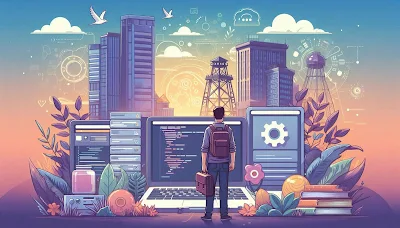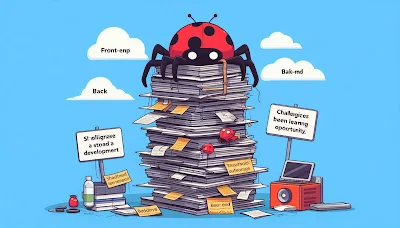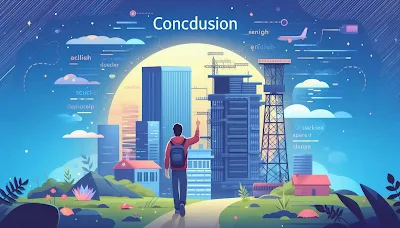Exploring Full-Stack Development: My Journey into Web Technologies
Introduction
What is Full-Stack Development?
Full-stack development refers to the practice of working on
both the front-end (client side) and back-end (server side) of web
applications. In essence, a full-stack developer possesses the skills necessary
to create fully functional and responsive web applications from scratch. This
role requires versatility, as it involves everything from designing user
interfaces to managing databases and server logic.
Front-End Development:
The front-end of a web application is what users interact
with directly. It encompasses the layout, design, and overall user experience,
making it a critical component of any application. The goal of front-end
development is to create a seamless, intuitive, and visually appealing
experience for users.
Technologies Used:
- HTML:
The backbone of any web page, HTML structures the content and provides the
basic layout.
- CSS:
CSS is used to style the HTML, adding colors, fonts, and other design
elements to make the page visually appealing.
- JavaScript:
JavaScript brings the page to life, enabling interactive features like
forms, animations, and dynamic content updates without reloading the page.
- Frameworks:
Popular frameworks like React.js and AngularJS streamline the process of
building complex, responsive user interfaces by providing reusable
components and managing application state.
Back-End Development:
The back-end of a web application is the unseen powerhouse
that drives functionality. It involves working with servers, databases, and
APIs to ensure that the front-end has all the data and capabilities it needs.
Back-end development is about ensuring that the application runs smoothly,
processes data correctly, and scales efficiently.
Technologies Used:
- Node.js:
An event-driven JavaScript runtime that allows developers to write
server-side code using JavaScript. Node.js is known for its efficiency and
scalability, particularly in handling asynchronous operations.
- Python
and PHP: These are popular back-end programming languages used to
build server logic, manage databases, and handle requests from the
front-end.
- Databases:
Both relational databases like MySQL and NoSQL databases like MongoDB are
used to store, retrieve, and manage application data. MongoDB, in
particular, offers flexibility and scalability, making it ideal for modern
applications.
- APIs:
APIs (Application Programming Interfaces) are crucial for communication
between the front-end and back-end, allowing the exchange of data and
execution of functions.
Why I Chose Full-Stack Development
My journey into full-stack development started with a simple
curiosity about how websites and web applications are built. Initially, I was
drawn to the visual aspect of front-end development—the creativity involved in
designing interfaces that users would interact with. However, as I delved
deeper into the technical aspects, I realized that understanding the back-end
was equally important for creating robust and dynamic applications. This
realization pushed me to explore full-stack development.
One of the most exciting aspects of being a full-stack
developer is the ability to see a project through from concept to completion. I
love the idea of being able to design an intuitive user interface while also
ensuring that the underlying infrastructure is solid and secure. Full-stack
development allows me to work on all aspects of an application, making the
process more cohesive and rewarding.
Technologies I’ve Learned So Far
Here's a look at some of the key technologies I’ve been
working with as I continue to grow as a full-stack developer:
React.js:
React.js is a JavaScript library that has been a game-changer for me in building responsive and dynamic user interfaces. Its component-based architecture makes it easier to manage complex UIs, allowing for the development of reusable, modular components. This not only streamlines the development process but also enhances the maintainability of the codebase.
- Key
Features:
- Virtual
DOM: React’s Virtual DOM optimizes rendering by updating only the
parts of the UI that have changed, improving performance.
- Component
Reusability: React encourages the creation of reusable components,
reducing duplication and making the code more maintainable.
- State
Management: Libraries like Recoil or Redux can be integrated with
React to manage application state more effectively.
Node.js:
Node.js has allowed
me to dive into server-side programming using JavaScript. Its event-driven
architecture is particularly well-suited for handling I/O-bound tasks, making
it a powerful tool for building scalable and efficient back-end services.
- Key
Features:
- Non-Blocking
I/O: Node.js uses an asynchronous, event-driven model, which allows
for handling multiple requests simultaneously without blocking the main
thread.
- Rich
Ecosystem: Node.js has a vast ecosystem of modules and libraries
available via npm (Node Package Manager), simplifying tasks such as
server setup, database connections, and API development.
- Cross-Platform:
Applications built with Node.js can run on multiple platforms, including
Windows, Linux, and macOS.
MongoDB:
Working with MongoDB has given me a better understanding of
how to store and manage data for web applications. As a NoSQL database, MongoDB
offers flexibility in handling unstructured data and scales horizontally,
making it an excellent choice for applications that require high performance
and availability.
- Key
Features:
- Schema
Flexibility: MongoDB allows for a flexible schema, meaning that the
structure of documents in a collection can vary, which is useful for
applications with evolving data requirements.
- High
Performance: MongoDB is designed for high throughput and low latency,
supporting applications that require real-time analytics.
- Scalability:
MongoDB supports sharding, allowing the database to be distributed across
multiple servers to handle large datasets and high traffic.
Projects and Practical Experience
To solidify my understanding of full-stack development, I've
been working on several projects that combine both front-end and back-end
technologies. These projects have not only challenged my technical skills but
also provided practical experience in managing full-stack development
processes.
E-Commerce Website:
One of the most
rewarding projects I've worked on is a simple e-commerce website where users
can browse products, add them to a cart, and make purchases. This project
required me to integrate front-end design with back-end functionality,
providing a complete user experience.
- Front-End:
Built with React.js, focusing on responsive design and user-friendly
navigation.
- Back-End:
Implemented using Node.js and MongoDB, handling product data, user
authentication, and order processing.
- Challenges:
Integrating payment gateways and managing state across different
components were significant challenges that I successfully navigated.
Personal Blog Platform:
Another project involved creating a personal blog platform,
which eventually became the foundation for this blog site. This project
required a deep dive into user authentication, database management, and
responsive design.
- Technologies
Used: React.js for the front-end, Node.js for the back-end, and
MongoDB for data storage.
- Features:
User authentication, CRUD operations for blog posts, and responsive design
for different devices.
- Challenges:
Ensuring data security and managing user sessions were critical aspects of
this project.
Data Science: Expanding My Skill Set
In addition to
full-stack development, I've also been exploring data science, which has
significantly expanded my understanding of how data can be leveraged to create
smarter applications. The courses I've taken through DevTown have been
instrumental in this journey, providing me with hands-on experience in machine
learning, data visualization, and predictive modeling.
Key Concepts:
- Machine
Learning: Developing algorithms that can learn from and make
predictions based on data.
- Data
Visualization: Using tools like Matplotlib and Seaborn to create
insightful visual representations of data.
- Predictive
Modeling: Building models that can forecast future trends based on
historical data.
Courses and Mentorship:
Throughout my journey, DevTown and 100Devs have played a
crucial role in my development. The structured courses and mentorship provided
by these platforms have not only enhanced my technical skills but also given me
the confidence to tackle complex projects. Their community-driven approach has
been incredibly supportive, making learning an enjoyable and rewarding
experience.
Challenges Faced and Lessons Learned
Full-stack development isn't without its challenges.
Balancing both front-end and back-end work can be overwhelming, especially when
troubleshooting bugs that could exist on either side of the stack. However,
each challenge has been a learning opportunity.
- Debugging
Asynchronous Code: Working with Node.js has taught me the importance
of understanding event-driven programming and error handling, especially
when dealing with asynchronous operations.
- State
Management: Managing state across different components in React.js has
been challenging but rewarding, as it has improved my ability to create
dynamic and responsive user interfaces.
- Database
Management: Learning to optimize queries and manage data effectively
in MongoDB has been crucial for building scalable applications.
What’s Next?
As I continue to explore full-stack development, I'm excited
to dive into more advanced topics like API integration, performance
optimization, and perhaps even exploring other back-end frameworks such as
Django or Ruby on Rails. My goal is to build increasingly complex applications
that not only solve problems but also offer a seamless user experience.
Conclusion
Full-stack
development has been an incredibly fulfilling journey so far. It has allowed me
to harness the power of both front-end and back-end technologies, creating
well-rounded applications that serve real-world needs. As I continue to learn
and grow, I'm eager to share more of my experiences and insights with you. The
journey into full-stack development is just beginning, and I look forward to
tackling new challenges, experimenting with different technologies, and
building even more robust and scalable applications. Whether it's optimizing
performance, exploring new frameworks, or integrating data science into my
projects, the possibilities are endless.
Thank you for joining me on this journey. I hope this post
has provided some insight into what full-stack development entails and inspired
you to explore this exciting field further. Stay tuned for more updates as I
continue to learn, grow, and share my experiences in the ever-evolving world of
technology.
Acknowledgements
A special thanks to
DevTown and 100Devs for their incredible courses and mentorship, which have
been instrumental in my full-stack development journey. Their resources and
community support have been invaluable, and I highly recommend them to anyone
looking to enhance their technical skills.
Call to Action
If you’re interested in full-stack development or have any
questions about the technologies I've discussed, feel free to reach out or
leave a comment below. I’d love to hear your thoughts and connect with others
who share a passion for technology.
Stay Connected
To stay updated on my
latest projects and blog posts, make sure to subscribe to my blog. You can also
follow me on social media for real-time updates and insights into my coding
journey.
Thank you for reading, and happy coding!
Related Posts:
- My Tech Blog Debut: Where It All Begins
- Balancing Academics and Mental Health: Essential Tips for College Students
- Navigating Mental Wellness in College: A Guide for Students
This completes my blog post on full-stack development. I
hope it serves as a valuable resource for anyone curious about the field or
looking to embark on a similar journey. Let's continue to learn and grow
together in this exciting world of technology.








Comments
Post a Comment